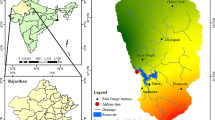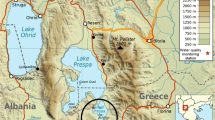Abstract
Nitrate-nitrogen concentrations in rivers represent challenges for water supplies that use surface water sources. Nitrate concentrations are often modeled using time-series approaches, but previous efforts have typically relied on monthly time steps. In this study, we developed a dynamic regression model of daily nitrate concentrations in the Raccoon River, Iowa, that incorporated contemporaneous and lags of precipitation and discharge occurring at several locations around the basin. Results suggested that 95 % of the variation in daily nitrate concentrations measured at the outlet of a large agricultural watershed can be explained by time-series patterns of precipitation and discharge occurring in the basin. Discharge was found to be a more important regression variable than precipitation in our model but both regression parameters were strongly correlated with nitrate concentrations. The time-series model was consistent with known patterns of nitrate behavior in the watershed, successfully identifying contemporaneous dilution mechanisms from higher relief and urban areas of the basin while incorporating the delayed contribution of nitrate from tile-drained regions in a lagged response. The first difference of the model errors were modeled as an AR(16) process and suggest that daily nitrate concentration changes remain temporally correlated for more than 2 weeks although temporal correlation was stronger in the first few days before tapering off. Consequently, daily nitrate concentrations are non-stationary, i.e. of strong memory. Using time-series models to reliably forecast daily nitrate concentrations in a river based on patterns of precipitation and discharge occurring in its basin may be of great interest to water suppliers.








Similar content being viewed by others
References
Benaglia, T., Chauveau, D., Hunter, D. R., & Young, D. S. (2009). Mixtools: an R package for analyzing mixture models. Journal of Statistical Software, 32, 1–29.
Cambardella, C. A., Moorman, T. B., Jaynes, D. B., Hatfield, J. L., Parkin, T. B., Simpkins, W. W., & Karlen, D. L. (1999). Water quality in Walnut Creek watershed: nitrate-nitrogen in soils, subsurface drainage water, and shallow groundwater. Journal of Environmental Quality, 28, 25–34.
Cryer, J. D., & Chan, K. S. (2008). Time series analysis with applications in R, 2nd edn. New York: Springer.
Gassman, P. W., Reyes, M. R., Arnold, J. G., & Green, C. (2007). The soil water assessment tool: developmental history, applications and future directions. Transactions of the American Society of Agricultural and Biosystems Engineers, 49, 1211–1250.
Ghosh, S. K., Prakash, V. B., Davis, J. M., & Lee, H. (2010). Spatio-temporal analysis of total nitrate concentrations using dynamic statistical models. Journal of the American Statistics Society, 105, 538–551.
Howden, N. J. K., & Burt, T. P. (2008). Statistical analysis of nitrate concentrations from the Rivers Frome and Piddle (Dorset, UK) for the period 1965–2007. Ecohydrology, 2, 55–65.
Jaynes, D. B., Hatfield, J. L., & Meek, D. W. (1999). Water quality in Walnut Creek watershed: herbicides and nitrate in surface waters. Journal of Environmental Quality, 28, 45–59.
Jha, M. K., Wolter, C. F., Schilling, K. E., & Gassman, P. W. (2010). Assessment of TMDL implementation strategies for the Raccoon River, Iowa. Journal of Environmental Quality, 39, 1317–1327.
Kleinbaum, D. G., Kupper, L. L., & Muller, K. E. (2008). Applied regression analysis and other multivariable methods, 4th edn. Belmont: Thompson.
McMullen, L. D. (2001). Remediation at the water treatment plant. In R. F. Follet & J. L. Hatfield (Eds.), Nitrogen in the environment: sources, problems and management (pp. 455–460). Amsterdam: Elsevier.
O’Brien, R. M. (2007). A caution regarding rules of thumb for variance inflation Factors. Quality and Quantity, 41, 673–690.
Royer, T. V., David, M. B., & Gentry, L. E. (2006). Timing of riverine export of nitrate and phosphorus from agricultural watersheds in Illinois: implications for reducing nutrient loading to the Mississippi River. Environmental Science and Technology, 40, 4129–4131.
Schilling, K. E. (2002). Chemical transport from paired agricultural and restored prairie watersheds. Journal of Environmental Quality, 31, 1184–1193.
Schilling, K. E., & Helmers, M. (2008). Tile drainage as karst: conduit flow and diffuse flow in a tile-drained watershed. Journal of Hydrology, 349, 291–301.
Schilling, K. E., & Lutz, D. S. (2004). Relation of nitrate concentrations to baseflow in the Raccoon River, Iowa. Journal of the American Water Resources Association, 40, 889–900.
Schilling, K. E., & Wolter, C. F. (2008). Water quality improvement plan for Raccoon River, Iowa, total maximum daily load for nitrate and Escherichia coli (p. 192). Des Moines: Iowa Department of Natural Resources.
Schilling, K. E., Zhang, Y. K., Hill, D. R., Jones, C. S., & Wolter, C. F. (2009). Temporal variations of Escherichia coli concentrations in a large Midwestern river. Journal of Hydrology, 365, 79–85.
Schloch, A. L., Schilling, K. E., & Chan, K. S. (2009). Time-series modeling of reservoir effects on river nitrate concentrations. Advances in Water Resources, 32, 1197–1205.
Tomer, M. D., Meek, D. W., Jaynes, D. B., & Hatfield, J. L. (2003). Evaluation of nitrate-nitrogen fluxes from a tile-drained watershed in central Iowa. Journal of Environmental Quality, 32, 642–653.
Tomer, M. D., Wilson, C. G., Moorman, T. B., Cole, K. J., Herr, D., & Isenhart, T. M. (2010). Source-pathway separation of multiple contaminants during a rainfall-runoff event in an artificially drained agricultural watershed. Journal of Environmental Quality, 39, 882–895.
Worrall, F., & Burt, T. P. (1999). A univariate model of river water nitrate time series. Journal of Hydrology, 214, 74–90.
Worrall, F., Swank, W. T., & Burt, T. P. (2003). Changes in stream nitrate concentrations due to land management practices, ecological succession, and climate: developing a systems approach to integrated catchment response. Water Resources Research, 39, 1177. doi:10.1029/2000WR000130.
Zhang, Y. K., & Schilling, K. E. (2005). Temporal variations and scaling of streamflow and baseflow and their nitrate-nitrogen concentrations and loads. Advances in Water Resources, 28, 701–710.
Acknowledgments
We are grateful to the US National Science Foundation (NSF-0934617) and the University of Iowa for partial support (2010 ICRU Summer Fellowship to ZF).
Author information
Authors and Affiliations
Corresponding author
Rights and permissions
About this article
Cite this article
Feng, Z., Schilling, K.E. & Chan, KS. Dynamic regression modeling of daily nitrate-nitrogen concentrations in a large agricultural watershed. Environ Monit Assess 185, 4605–4617 (2013). https://doi.org/10.1007/s10661-012-2891-7
Received:
Accepted:
Published:
Issue Date:
DOI: https://doi.org/10.1007/s10661-012-2891-7




